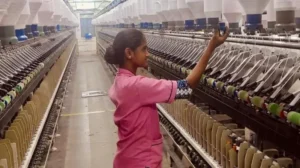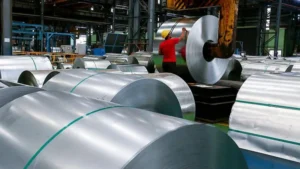Indian Spinning Mills Struggle as Cheaper Chinese Yarn Floods Market
The spinning mills of Tamil Nadu are facing a serious slowdown. At 64, Thirunavkarsu, a veteran mill owner in southern India, says his production of viscose yarn — essential for woven garments — has sharply declined. Orders from local factories have dropped by nearly 40% in just one month.
The reason? A surge of cheaper Chinese viscose yarn imports, undercutting Indian prices by ₹15 ($0.18) per kilo, is overwhelming domestic producers. This influx follows new U.S. tariffs on Chinese goods, prompting Chinese manufacturers to redirect their exports to markets like India.
India’s textile sector, particularly in hubs like Pallipalayam, Karur, and Tirupur, is feeling the pressure. Nearly 50 small spinning mills are reportedly scaling back operations, according to Jagadesh Chandran of the South India Spinners Association.
“Matching Chinese prices is impossible. Our raw materials cost more,” says Thirunavkarsu, worried his mill might not survive the price war.
Despite India’s strong domestic viscose production, the market is now being disrupted by what industry experts call “dumping” — a move that could cripple small and medium-sized mills unless swift action is taken.

China Denies Dumping Claims as Concerns Mount in Indian Industry
China’s Ambassador to India, Xu Feihong, has sought to reassure Indian authorities and industries amid rising concerns over the flood of cheap Chinese imports. In an opinion piece published in the Indian Express, Xu stated that China has no intention of engaging in dumping practices or disrupting other nations’ economic development.
“We will not engage in market dumping or cut-throat competition,” he emphasized, adding that China is instead looking to import more high-quality goods from India for its own growing consumer market.
Despite these diplomatic assurances, anxiety continues to spread across multiple sectors in India. As Asia’s largest economy and the world’s top exporter of industrial goods—ranging from textiles and chemicals to electronics and rare minerals—China’s export power is being felt more than ever in emerging markets like India.
Much of the concern stems from the U.S.’s steep tariffs—up to 145%—on Chinese goods under Donald Trump’s trade policies. While critical sectors like pharmaceuticals, electronics, and semiconductors are exempt, a wide range of other Chinese exports are now being redirected toward alternative markets, India included.

Analysts warn that this diversion could severely impact developing economies. Japanese brokerage firm Nomura reports that China was already oversupplying global markets with cheap goods even before the latest U.S. tariffs, calling the current trend “highly disruptive.”
According to World Trade Organization (WTO) data, 2024 saw a record surge in anti-dumping investigations against China—nearly 200 in total, with 37 initiated by India alone.
India’s growing dependence on Chinese imports has left it vulnerable. The country’s trade deficit with China has ballooned to $100 billion, and imports spiked by 25% in March, led by electronics, batteries, and solar components.
In response, the Indian government has taken steps to stem the tide. A dedicated committee has been formed to monitor the inflow of low-cost Chinese goods, while India’s trade regulator is actively probing sectors like viscose yarn for signs of unfair trade practices. A 12% safeguard duty was also recently imposed on certain steel imports, mainly to shield local manufacturers from underpriced Chinese shipments.
However, reducing dependency has proven challenging. Despite border tensions and campaigns like “Make in India,” China’s dominance in intermediate goods—crucial for manufacturing finished products—continues. Trade expert Biswajit Dhar notes that India’s production-linked incentive (PLI) schemes have seen “limited success” in shifting the manufacturing balance.
As China looks for new export destinations, the pressure on India’s local industries could intensify—forcing policymakers to strike a difficult balance between trade, diplomacy, and domestic economic resilience.
India’s Trade Deficit with China Deepens as Concerns Over Dumping and Dependency Mount
As Western tech giants like Apple begin diversifying their manufacturing operations to India, the country remains heavily reliant on Chinese components—especially in the electronics sector. This dependence has caused a sharp rise in imports, worsening India’s already ballooning trade deficit with China.
Ajay Srivastava, founder of the Global Trade Research Initiative (GTRI), calls the growing deficit a “serious concern,” especially since India’s exports to China have now dropped below 2014 levels—even as the Indian rupee has weakened, which should have made exports more competitive.
“This is more than just a trade gap—it’s a structural red flag,” Srivastava wrote in a recent social media post. He pointed out that government-backed production-linked incentive (PLI) schemes are ironically increasing import demand rather than fostering genuine domestic manufacturing capacity. “Without closing our competitiveness gap, we cannot close the trade deficit.”
With U.S.-China trade tensions continuing, experts believe India must act swiftly to seize the opening created by shifting global supply chains. But there’s also a cautionary tale: according to Japanese financial firm Nomura, countries that witness a surge in Chinese imports often experience a sharp deceleration in their own manufacturing growth.
Investment hesitancy among Indian private companies is also linked to these dynamics. Akash Prakash of Amansa Capital recently noted in Business Standard that many domestic firms fear being overwhelmed by cheap Chinese imports, a concern echoed by a recent study from ICRA ratings agency.
Meanwhile, global apprehension over Chinese dumping is intensifying. The European Union has pressed Beijing for assurances that its markets won’t be inundated with underpriced Chinese goods. In this shifting environment, China is actively seeking new trading partners to offset its declining presence in the U.S. market.
“China wants to reset its image,” says trade expert Biswajit Dhar. “Amid rising global scrutiny, it’s trying to clean up its narrative.”
Despite Beijing’s diplomatic overtures, Dhar argues that India must stand firm and use this moment to initiate a strategic dialogue. “This is the right time for Delhi to raise its concerns on dumping—just as many Western nations have already done.”
As India tries to strengthen its role in global supply chains, striking a balance between attracting foreign investment and reducing reliance on Chinese imports will be crucial for long-term economic resilience.

